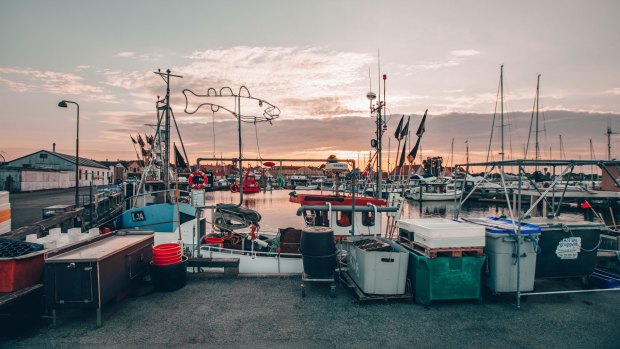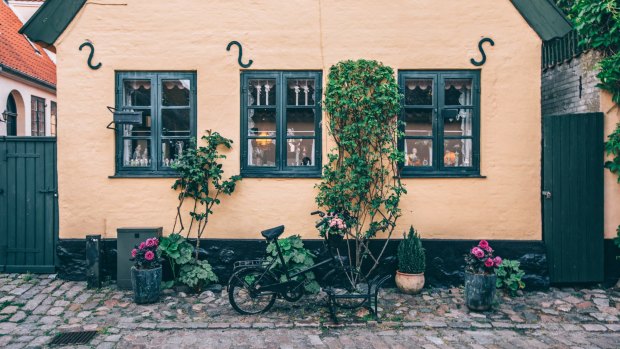This was published 4 years ago
Denmark, Dragor: A crowd-free slice of old-school Denmark
By Steve McKenna

Harbourside Dragor was originally founded by Dutch settlers. Credit: Astrid Maria Rasmussen/Copenhagen Media Center
An hour after jostling for photographs by the Little Mermaid – the tiny, yet iconic crowd-pulling sculpture on Copenhagen's harbour-front – we are mooching around the quaint, postcard-pretty cobblestone lanes of Dragor. And apart from the dozen or so people in our group, there's not another tourist in sight.
While Copenhagen has become one of Europe's top visitor magnets, thanks to its opulent royal sites, cool, cutting-edge architecture and acclaimed neo-Nordic restaurants, Dragor offers a (usually) crowd-free slice of old-school Denmark.
Founded in the 12th century, this traditional fishing village is perched on the south-east coast of Amager, an island linked by bridges and tunnels to Zealand, which is the largest of Denmark's 407 islands and contains most of the country's capital.

Cute cobblestoned streets.Credit: Astrid Maria Rasmussen/Copenhagen Media Center
Amager is built-up and densely-populated, home to residential and business districts and Copenhagen's ever-expanding airport, but this pear-shaped, pancake-flat island retains a rural flavour. It's carpeted with fields of oat, rye, wheat and rapeseed, and dotted with beaches, dunes, lagoons and tranquil villages where Copenhageners come to take a break from city life.
Our Danish guide, Maria-Anne, walks us beside Dragor's little harbour, revealing the seafaring past of a village whose name originates from the act of dragging boats ashore. This was a port of call for ships from the Hanseatic League – a medieval trading bloc that dominated northern Europe – but fishing was Dragor's bread and butter. It boasted one of Denmark's largest fishing fleets and also had thriving fish salting and processing industries.
The boom years are over, but cod, herring, plaice and mackerel are still treated in the burgundy-hued smokehouse by the harbour, where modest fishing and leisure vessels bob. Maria-Anne points out Elisabeth K571, a boat that, in World War II, ferried Jews fleeing Nazi-occupied Denmark to "neutral" Sweden.
It's believed that local fishermen helped about 7000 Jews over the Oresund, the strait dividing the two countries. Most people make the crossing now on the Oresund Bridge, a late 20th-century marvel of engineering that is visible, in the distance, from Dragor's shores. It played a starring role in the Scandi noir TV drama, The Bridge.
In the early 16th century, about 20 farming families from the Netherlands landed at Dragor, invited by king Christian II to produce food for the Danish royal household. The Dutch were regarded then as a more agriculturally advanced people and the immigrants settled in Store Magleby, Dragor's neighbour up the road, sparking a rivalry between the two villages, and between fishermen and farmers, which apparently endures to this day.
It's hard, though, to imagine any commotion blighting the peace and quiet as we navigate Dragor's idyllic antique core, where old cottages, mostly painted white or yellow, are topped by vivid orange tiles or elaborate thatched roofs pierced by windows that resemble huge eyes.
On this mild spring afternoon, honeysuckle and hollyhock creep up over garden fences. Maria-Anne says the properties are sought after, with average prices around $A1 million. Danish artists and politicians are among the owners.
She points out bygone little porcelain dog statuettes in cottage windows. Traditionally, depending on which way the dogs faced, they would indicate if the man of the house was home or out fishing. Some windows also have tilted mirrors, which allowed housewives to keep an eye on their children playing on the cobbles outside as they weaved or sewed indoors.
We break for coffee and a custard and almond pastry at Dragor Strand Hotel, one of Denmark's oldest inns, then have free time to amble along the village's main drag, which is lined with a few eclectic boutiques, a cafe and bakery, a hairdresser, a supermarket and a couple of sushi restaurants.
Buoyed by Dragor's picturesque, laid-back charms, we return to Copenhagen, where we have a dilemma: enjoy our final evening aboard Viking Jupiter, our Nordic-chic ship, or head out to savour the smorgasbord of temptations in the buzzing Danish capital.
CRUISE
Copenhagen is a port of call on several Viking cruises, including 12-day voyages between Bergen and Copenhagen. It's priced from $6695 a person, based on double occupancy. Some shore excursions are included in the fare, but Dragor (Charming Coastal Copenhagen) is an extra, costing around $100. See vikingcruises.com.au
TOUR
If travelling independently, bus 250S runs regularly between central Copenhagen and Dragor. See dinoffentligetransport.dk/tourist
Sign up for the Traveller Deals newsletter
Get exclusive travel deals delivered straight to your inbox. Sign up now.